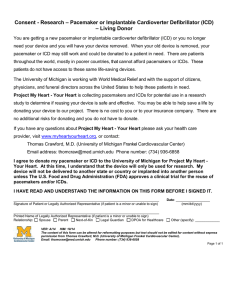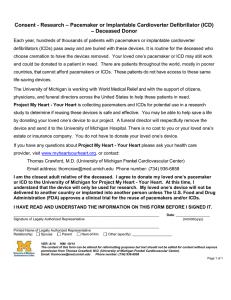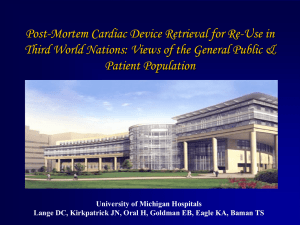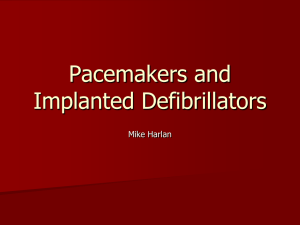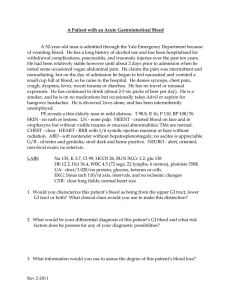Implanted electronic devices at endoscopy
advertisement
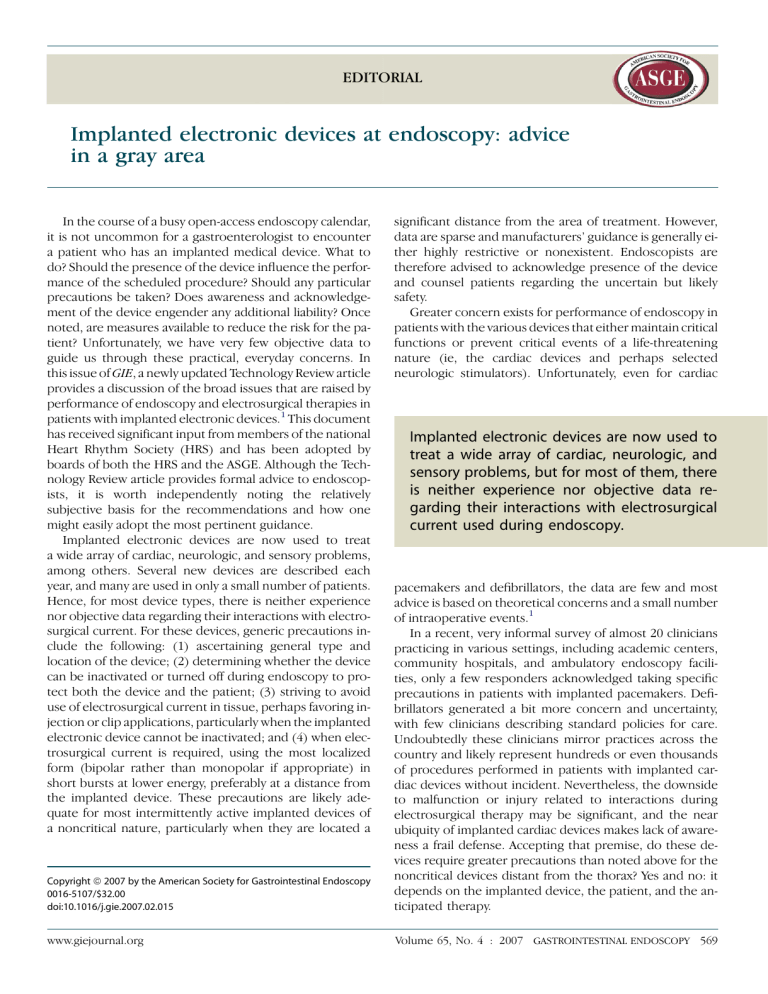
EDITORIAL Implanted electronic devices at endoscopy: advice in a gray area In the course of a busy open-access endoscopy calendar, it is not uncommon for a gastroenterologist to encounter a patient who has an implanted medical device. What to do? Should the presence of the device influence the performance of the scheduled procedure? Should any particular precautions be taken? Does awareness and acknowledgement of the device engender any additional liability? Once noted, are measures available to reduce the risk for the patient? Unfortunately, we have very few objective data to guide us through these practical, everyday concerns. In this issue of GIE, a newly updated Technology Review article provides a discussion of the broad issues that are raised by performance of endoscopy and electrosurgical therapies in patients with implanted electronic devices.1 This document has received significant input from members of the national Heart Rhythm Society (HRS) and has been adopted by boards of both the HRS and the ASGE. Although the Technology Review article provides formal advice to endoscopists, it is worth independently noting the relatively subjective basis for the recommendations and how one might easily adopt the most pertinent guidance. Implanted electronic devices are now used to treat a wide array of cardiac, neurologic, and sensory problems, among others. Several new devices are described each year, and many are used in only a small number of patients. Hence, for most device types, there is neither experience nor objective data regarding their interactions with electrosurgical current. For these devices, generic precautions include the following: (1) ascertaining general type and location of the device; (2) determining whether the device can be inactivated or turned off during endoscopy to protect both the device and the patient; (3) striving to avoid use of electrosurgical current in tissue, perhaps favoring injection or clip applications, particularly when the implanted electronic device cannot be inactivated; and (4) when electrosurgical current is required, using the most localized form (bipolar rather than monopolar if appropriate) in short bursts at lower energy, preferably at a distance from the implanted device. These precautions are likely adequate for most intermittently active implanted devices of a noncritical nature, particularly when they are located a significant distance from the area of treatment. However, data are sparse and manufacturers’ guidance is generally either highly restrictive or nonexistent. Endoscopists are therefore advised to acknowledge presence of the device and counsel patients regarding the uncertain but likely safety. Greater concern exists for performance of endoscopy in patients with the various devices that either maintain critical functions or prevent critical events of a life-threatening nature (ie, the cardiac devices and perhaps selected neurologic stimulators). Unfortunately, even for cardiac Implanted electronic devices are now used to treat a wide array of cardiac, neurologic, and sensory problems, but for most of them, there is neither experience nor objective data regarding their interactions with electrosurgical current used during endoscopy. Copyright ª 2007 by the American Society for Gastrointestinal Endoscopy 0016-5107/$32.00 doi:10.1016/j.gie.2007.02.015 pacemakers and defibrillators, the data are few and most advice is based on theoretical concerns and a small number of intraoperative events.1 In a recent, very informal survey of almost 20 clinicians practicing in various settings, including academic centers, community hospitals, and ambulatory endoscopy facilities, only a few responders acknowledged taking specific precautions in patients with implanted pacemakers. Defibrillators generated a bit more concern and uncertainty, with few clinicians describing standard policies for care. Undoubtedly these clinicians mirror practices across the country and likely represent hundreds or even thousands of procedures performed in patients with implanted cardiac devices without incident. Nevertheless, the downside to malfunction or injury related to interactions during electrosurgical therapy may be significant, and the near ubiquity of implanted cardiac devices makes lack of awareness a frail defense. Accepting that premise, do these devices require greater precautions than noted above for the noncritical devices distant from the thorax? Yes and no: it depends on the implanted device, the patient, and the anticipated therapy. www.giejournal.org Volume 65, No. 4 : 2007 GASTROINTESTINAL ENDOSCOPY 569 Editorial Petersen Precautions to be taken with all patients with implanted cardiac devices include all of those listed above for generic devices as well as use of continuous electrocardiographic monitoring, if this is not already a standard for all patients in the unit. In general, all pacemakers can be left on, with or without conversion to a continuously paced mode (as outlined below), and most defibrillators should be inactivated for procedures with anticipated use of electrosurgical currents, after initiating rhythm monitoring. For pacemakers, brief consideration should be given to the patient’s reliance on the implanted device. Among patients with cardiac pacemakers, approximately 20% are dependent on their pacemaker for moment-to-moment maintenance of adequate rhythm and hemodynamics. This group of patients has a greater risk in the event of device malfunction than those with a usually adequate native rhythm whose pacemakers are implanted to guard against intermittent profound episodes of bradycardia. Pacemaker dependency is most obviously apparent when cardiac rhythm monitoring demonstrates a predominantly paced rhythm. Conservative guidance in the Technology Review article suggests that we should identify patients who are pacemaker dependent in advance and use modest additional precautions to ensure sustained pacemaker function when they require prolonged use of electrocautery. Alternatively, while not strongly advocated, similar precautions could be taken for use of electrocautery in all patients with implanted pacemakers. Placement of a ring magnet directly over a pacemaker site forces a continuous paced beat. This should be used only briefly for the few minutes during which electrocautery is actually being delivered, particularly when treating in close proximity to the heart and/or when using prolonged bursts of energy, as in the delivery of argon coagulation to broad areas or during endoscopic mucosal resection or polypectomy of broad lesions or thick pedunculated stalks. Inactivating defibrillators before endoscopy prevents their inadvertent delivery of a cardioverting shock in response to electrosurgical currents. This requires pre- and postprocedure adjustments by a cardiovascular rhythm specialist, nurse, or technician using transcutaneous control devices, as well as continuous monitoring during the unprotected interval. Some defibrillators have integrated pace- maker functions. The advice of the patient’s rhythm specialist should be sought for those patients who are pacemaker dependent and have dual function devices, because programmed responses to application of a ring magnet vary among the implanted defibrillators and may be detrimental. After endoscopic procedures that include the use of a ring magnet on a pacemaker or the inactivation of a defibrillator, and before patient discharge, the cardiac device should be reactivated or assessed for normal function. For pacemakers, this can often be done telephonically, as patients frequently do from home. For defibrillators, this requires brief return of the specialty nurse to the recovery area. For many practices, particularly in hospital settings, the measures outlined in the accompanying review are already standard. For others, perhaps more so in free-standing centers, they pose modest logistical issues. In the future, uniformity in control mechanisms for the defibrillators would ease the uncertainty for practitioners and potential risks for the patient. It is hoped that better outcomes data will be forthcoming regarding the more commonly used devices and that better data-driven guidance will be provided by manufacturers for the uncommon devices. In the meantime, awareness and attention to the modest principles above should minimize risk and enhance patient safety. 570 GASTROINTESTINAL ENDOSCOPY Volume 65, No. 4 : 2007 www.giejournal.org DISCLOSURE The author has no pertinent conflicts of interest. Bret T. Petersen, MD Advanced Endoscopy Unit Gastroenterology and Hepatology Mayo Clinic College of Medicine Rochester, Minnesota, USA REFERENCE 1. American Society of Gastrointestinal Endoscopy. Endoscopy in patients with implanted electronic devices. Gastrointest Endosc 2007;65:563-70. TECHNOLOGY STATUS EVALUATION REPORT Endoscopy in patients with implanted electronic devices The ASGE Technology Committee provides reviews of existing, new, or emerging endoscopic technologies that have an impact on the practice of gastrointestinal endoscopy. Evidence-based methodology is used, with a MEDLINE literature search to identify pertinent clinical studies on the topic and a MAUDE (Food and Drug Administration Center for Devices and Radiological Health) database search to identify the reported complications of a given technology. Both are supplemented by accessing the ‘‘related articles’’ feature of PubMed and by scrutinizing pertinent references cited by the identified studies. Controlled clinical trials are emphasized, but in many cases data from randomized controlled trials are lacking. In such cases, large case series, preliminary clinical studies, and expert opinions are utilized. Technical data are gathered from traditional and Web-based publications, proprietary publications, and informal communications with pertinent vendors. Technology Status Evaluation Reports are drafted by 1 or 2 members of the ASGE Technology Committee, reviewed and edited by the committee as a whole, and approved by the Governing Board of the ASGE. When financial guidance is indicated, the most recent coding data and list prices at the time of publication are provided. For this review, the MEDLINE database was searched through September 2006 for articles related to endoscopy in patients with implanted electronic devices by using the keywords ‘‘gastrointestinal endoscopy’’ and ‘‘electrocautery’’ paired with ‘‘pacemaker,’’ ‘‘defibrillator,’’ ‘‘ICD,’’ and each of the miscellaneous noncardiac devices. In addition, this document also received review and contributions from physician representatives of the Heart Rhythm Society (Washington, DC). Technology Status Evaluation Reports are scientific reviews provided solely for educational and informational purposes. Technology Status Evaluation Reports are not rules and should not be construed as establishing a legal standard of care or as encouraging, advocating, requiring, or discouraging any particular treatment or payment for such treatment. BACKGROUND Endoscopy is commonly performed in patients with implanted electronic devices. Electrocautery is used in many endoscopic procedures. Endoscopists must be familiar with the potential for patient injury or interference with device function as a result of endoscopic intervention. This article will address the risks and the appropriate management strategies for endoscopy and the use of electrocautery in patients with implanted electronic devices, including the following: (1) cardiac devices (pacemakers and defibrillators), (2) neurostimulators (deep brain, gastric, spinal cord, sacral nerve, and urinary bladder stimulators), and (3) drug-infusion pumps (chemotherapy and pharmacotherapy infusion pumps) (Table 1). Other risks of GI endoscopy in patients with implanted electronic devices that are unrelated to electromagnetic interference are not addressed. Guidance regarding potential risks related to infection,1 performance of wireless capsule endoscopy,2 or wireless pH monitoring3 is available in other guidelines or technology evaluations. TECHNICAL ISSUES Electrocautery use during GI endoscopy Copyright ª 2007 by the American Society for Gastrointestinal Endoscopy 0016-5107/$32.00 doi:10.1016/j.gie.2006.09.001 Electrocautery involves the application of radiofrequency current in a unipolar or bipolar/multipolar fashion to cut and/or coagulate tissues. In unipolar cautery, current passes from the active electrode of the electrosurgical device, through the patient to a distant return electrode (grounding pad), and back to the generator. During bipolar and multipolar cautery, current flows from 1 or more electrodes located on an electrosurgical device through immediately adjacent tissue and returns to 1 or more electrodes on the same instrument. During electrocautery, the resistance to flow of current generates heat, which enables electrocoagulation or electrosection (cutting effect). Coagulation occurs with short bursts of relatively low-energy current, whereas cutting uses continuous current generating high temperatures, which cause cell explosion and evaporation.4 Newer-generation electrosurgical generators use programmable blends of coagulation and cutting current. The most common applications of monopolar cautery include the performance of endoscopic polypectomy (primarily in the colon or the stomach) and endoscopic sphincterotomy of the biliary or pancreatic sphincters at www.giejournal.org Volume 65, No. 4 : 2007 GASTROINTESTINAL ENDOSCOPY 561 ASGE technology status evaluation report TABLE 1. Device classes and devices Patient controlled functions Device Sensing capabilities On-off Voltage or rate Alter programming for electrocautery? Pacemakers Yes, most No No Situational, see text ICD Yes No No Yes, with specialty input DBS No Yes No See text GES No Yes Yes See text Other neurostimulators (spinal cord, peripheral nerve, urinary bladder, cochlear) No Most yes Most yes Yes Pharmacologic agents (eg, narcotics, Lioresal, PGI2) No No Most no Most no Chemotherapeutic agents (floxuridine) No No Most no Most no Device class Cardiac Neurostimulators Medication delivery pumps the major or minor papillae in the duodenum. ‘‘Hot biopsy’’ is a special form of polypectomy in which monopolar cautery is used to simultaneously coagulate and ablate the base of small polyps during sampling.5 Monopolar cautery is also used during the application of argon plasma coagulation for control of hemorrhage or for ablation of mucosal lesions, such as vascular malformations or residual polyp tissue.6 In this ‘‘noncontact’’ technique, the monopolar circuit is completed by passage of current via a stream of argon ions from the device tip to the tissue. In most monopolar applications, the duration of cautery is controlled by stepping on a foot pedal for the desired intervals of !1 second to 10 seconds or more. Bipolar and multipolar cautery are used during direct application of ‘‘bicap’’ probes for control of local hemorrhage from ulcers or other vascular lesions.7 Power application can vary from brief pulses of!1 second to continuous application. The Olympus heat probe (Olympus Optical Co, Ltd, Tokyo) is a nonconductive hemostatic probe with a Tefloncoated tip that is heated by an internal electrical resister. No current is passed through the tissues to either a local or distant electrode; hence, the induced electromagnetic field (EMF) (see below) is negligible. Electromagnetic interference (EMI) refers to the effect of an EMF on the function of any electronic device. EMI occurs as a result of 2 forms of EMF: conducted and radiated. Conducted EMI occurs when an electromagnetic source comes in direct contact with the body (eg, electrocautery or defibrillation). Radiated EMI occurs when the body is placed in an EMF (eg, magnetic resonance imaging). Variables related to endoscopic or surgical electrocautery devices that determine the likelihood of interference with implanted devices include the intensity of the generated EMF, the frequency and waveform of the signal, the distance between the electrocautery application and the leads of the implanted device, and the orientation of the leads with respect to the EMF.8 Cutting current may be more likely to cause EMI than coagulation current.9 Because bipolar and multipolar devices induce only a limited flow of current beyond the site of application, a very localized EMF is generated and EMI is less likely compared with monopolar devices. Use of electrocautery can induce an EMF as high as 60 V/m. Variables that determine the sensitivity of an implanted device to an EMF include the presence and the number of leads, the distance between the anode and the cathode of the implanted device (smaller distance in bipolar leads vs unipolar leads), and the programmed sensitivity of the device to an electrical signal. Implanted devices that use bipolar sensing are less likely to experience EMI.10 Theoretically, EMI generated by an electrosurgical instrument on an implanted device can be manifested in the following ways10: 1. The signal may be interpreted as physiologic or pathophysiologic, temporarily inhibiting or triggering output. 562 GASTROINTESTINAL ENDOSCOPY Volume 65, No. 4 : 2007 www.giejournal.org Principles of electromagnetic interference ASGE technology status evaluation report For example, the signal could be sensed as intrinsic cardiac electrical activity, with inhibition of a pacemakers output or as ventricular fibrillation (VF) resulting in discharge of an implantable cardioverter-defibrillator (ICD). 2. The signal may be interpreted as noise, temporarily or permanently causing the device to revert to a mode preset by the manufacturer. 3. High levels of current may pass though the implanted leads and damage the contiguous tissue. 4. A continuous train of electrical impulses may be conducted down the leads of an implanted device and cause inappropriate stimulation of the target tissue, such as ventricular or atrial fibrillation with pacemakers or ICDs. 5. High levels of current may cause irreversible loss of battery power or permanent destruction of the device. Because of the very different nature of the devices, cardiac devices, neurostimulators, drug-infusion pumps, and other devices will be considered separately in this report. For further discussion of EMI and the potential interaction with implanted cardiac devices, the reader is referred to recent reviews of the subject.11-13 Situations 3, 4, and 5 above are very unlikely to occur in modern pacemakers and ICDs unless the current source is applied in very close proximity to the pulse generator or the lead electrodes, which is unlikely to occur in GI endoscopic procedures. CARDIAC DEVICES Two major classes of cardiac-rhythm–management devices are commonly used: pacemakers and ICDs. These devices have significantly different risks for abnormal function or injury and, hence, differing recommendations for their management during the use of electrocautery. Cardiac pacemakers may be programmed in asynchronous modes (where the pacemaker paces but does not sense the atria or ventricle or both chambers) or synchronous modes (capable of sensing the atrial or ventricular impulse or both). All currently implanted pacemakers have programmable features (including, eg, control over pacing mode, rate, stimulus output, sensitivity, rateresponsiveness), the nature of which depends on the type of pacemaker used.14 The sensing thresholds of pacemakers (as low as 0.1 mV) are well below the EMFs induced by use of electrosurgical therapy, that is, electrosurgical current applied near pacemakers may be easily sensed as intrinsic cardiac electrical activity.15 Pacemakers are implanted in patients for a variety of indications, most commonly sinus-node dysfunction and atrioventricular (AV) block. The term ‘‘pacemaker dependent’’ is used to refer to patients who require cardiac pacing most or all of the time to maintain a physiologically adequate heart rate. This situation most commonly occurs in patients with a high-degree or a complete AV block. www.giejournal.org ICDs successfully terminate VF in over 98% of episodes9,10 and have been shown to reduce mortality.11 The indications for ICD use are expanding and now include not only patients with a history of ventricular arrhythmia but those found at risk because of left ventricular dysfunction.16-18 This device consists of a pulse generator and 1 or more leads for pacing and defibrillation electrodes. The pulse generator has a titanium case that houses a battery, voltage converters, capacitors, and other electronic capabilities of a pacemaker. Current ICD devices weigh 50 to 100 g, have a 30- to 70-mL volume, and are usually implanted in the anterior pectoral location, similar to a pacemaker.19 Some patients who have retained older epicardial or endocardial ICD systems or who have no upper-extremity venous access may have a generator implanted in the abdomen, usually in the left upper quadrant above the rectus muscle. Current-generation ICDs can perform all pacemaker functions, including biventricular pacing; some patients with ICDs are also pacemaker dependent, usually because of concomitant AV block. ICDs sense ventricular rate (R-R interval) by using a true or modified bipolar-sensing electrode, usually implanted on the endocardial surface of the right ventricle. ICDs detect ventricular tachyarrhythmias by sensing a number of R-R intervals above a rate threshold for a given duration, all these variables are programmable. Typical tachycardia detection criteria are rates higher than 150 to 200 bpm for 3 to 5 seconds. Ventricular tachycardia (VT) and VF events that meet detection criteria are treated by the delivery of antitachycardia pacing (ATP) for VT, countershocks for VT or VF, and antibradycardia pacing as needed for a short time after delivery of a counter shock. Patients may also use the antibradycardiac pacing functions of the ICD chronically. The specific criteria for arrhythmia detection, cardioversion, and defibrillation vary between models and manufacturers, and are programmable.14 The signal caused by electrocautery is 1600 times greater than the sense threshold of the ICD and, hence, can be detected as VT or VF by ICDs if the signal is sufficiently close to the sensing electrode and prolonged to meet programmed detection criteria (D. Ruzin, Medtronic Inc, written communication, October, 2005). Safety issues with cardiac devices Published data regarding safety of endoscopic electrocautery use in patients with implanted cardiac pacemakers are limited and anecdotal. Two case series with limited numbers of procedures report safe use of electrocautery, without specific precautions during endoscopy in patients with pacemakers.20,21 Serious adverse events related to the endoscopic application of electrocautery in patients with pacemakers have not been reported. Adverse events occurring during the use of intraoperative electrocautery in patients with a pacemaker have Volume 65, No. 4 : 2007 GASTROINTESTINAL ENDOSCOPY 563 ASGE technology status evaluation report decreased as a consequence of the increasing use of bipolar leads and improved pacemaker design, but they still occur.22-29 Reports of intracardiac device malfunction in this setting include pacing inhibition, pacing triggering, automatic mode switching, spurious tachyarrhythmia detection,30 electrical reset,11,12 myocardial burns,13 VF,31 the runaway pacemaker syndrome,24 and irreversible loss of output.32 Although the likelihood is low, transient pacemaker inhibition during actual delivery of electrocautery could occur, with resulting severe bradycardia or asystole in patients dependent on a pacemaker. In theory, electrosurgical cautery in patients with ICDs could elicit inappropriate countershocks by the pulse generator, ATP, suspension of arrhythmia detection, or permanent damage/malfunction of the implanted device. However, there are no published reports of these events during endoscopy or surgery. The absence of such reports may be because of a general practice of temporarily inactivating ICDs during procedures in which electrocautery is used. Two series report experience with electrosurgical devices in a total of 4 dogs and 48 patients. There was uniform absence of sensing of the electrosurgical signal or ICD charging, reprogramming, malfunction, or damage.33,34 Despite the lack of reported events because of EMI, the potential risks of electrocautery should be considered in patients with ICDs undergoing an endoscopy and appropriate precautions taken. Because of limited available data on the safety and effectiveness of different strategies for cardiac-device management during endoscopy, as well as different features available in different cardiac-device makes and models, universal recommendations applying to all patients in all practice settings cannot be made at the present time. A Practice Advisory for the Perioperative Management of Patients with Cardiac Rhythm Management Devices,35 based upon a survey by the American Society of Anesthesiology (ASA), provides a useful review of the subject even though few points of broad consensus were achieved. Manufacturers’ Web sites and device-specific literature are helpful sources of guidance regarding interventions in patients with implanted devices. Manufacturers’ recommendations are often based on anecdotal case series and reports of pacemaker malfunction during surgery but not during GI endoscopy specifically. In the absence of data, the theoretical risk for significant morbidity led some manufacturers to issue recommendations that electrocautery or other therapies that generate EMFs should be avoided whenever possible in patients with implanted devices. At the present time, the preponderance of data support the safe use of electrocautery in patients who have pacemakers and ICDs, with proper precautions. For patients with either pacemakers or ICDs, periprocedural planning should include obtaining information on the cardiac device make, model, type (eg, single chamber, dual chamber, biventricular), indication for the device, degree of pacemaker dependence, and the patient’s underlying heart rhythm. For those with an ICD, a history of device utilization to treat VT and VF is also useful. Such patients are usually followed at regular intervals (every 3-6 months) in specialized device clinics and/or by heart rhythm specialists trained in device management. The patient’s cardiology provider should be able to provide these data, as well as information regarding how the patient’s device will respond to a magnet and advice regarding whether and how the patient’s device should be reprogrammed during the procedure. Pacemaker interrogation and reprogramming immediately before and after the procedure allows control over the pacemaker rate but is not always feasible in all practice settings and clinical situations because of a lack of availability of qualified personnel to perform this task. In some practice settings, transtelephonic monitoring may be performed to check basic pacemaker function. Internet-based home monitoring of some ICDs has recently become available. In the future, similar monitoring of pacemaker and ICD function in the postprocedure setting may be possible. Patients who are pacemaker dependent patients (ie, those with complete AV block) and are undergoing endoscopy in which prolonged electrocautery (especially unipolar) is anticipated may require temporary (via magnet application) or permanent reprogramming of the pacemaker to an asynchronous mode (VOO or DOO). In general, a magnet held or taped in the proper position over a pacemaker generator will result in asynchronous pacing at a constant rate prespecified by the manufacturer (generally 70 to 100 bpm). The principal advantage of magnet application is ease of use and reversibility of the intervention. One disadvantage is that pacemakers with magnet rates near 100 bpm may not be well tolerated by some patients at rest. The magnet response varies among manufacturers and device models. Most patients with modern pacemaker systems who are not pacemaker dependent (ie, patients with infrequent symptoms because of intermittent sinus-node dysfunction) will not require temporary or permanent pacemaker reprogramming for endoscopic procedures. Indeed, some patients with normal intrinsic heart rhythm will become symptomatic if programmed to asynchronous pacing mode, because of palpitations or diminution of cardiac output. In addition, although extremely rare, the potential for asynchronous-pacing–induced proarrhythmia is present. If pacemaker reprogramming is not performed, operators should be prepared to recognize and manage infrequent responses to electrocautery, such as ventricular pacing at the upper rate limit (because of rate-responsive behavior or ventricular tracking of sensed signal on the atrial channel), mode switching, and noise reversion to an asynchronous pacing mode. In general, these 564 GASTROINTESTINAL ENDOSCOPY Volume 65, No. 4 : 2007 www.giejournal.org Management of patients with cardiac devices ASGE technology status evaluation report responses, if they occur, will be transient and limited to the period during which electrocautery is applied. For patients with ICDs, a principal concern regarding the use of electrocautery is the potential for triggering inappropriate ICD therapy. Inappropriate ATP during sinus rhythm may induce VT or VF in a susceptible patient. ICD discharges, especially repetitive discharges in an awake patient, may be psychologically traumatic, may induce arrhythmia or cause hemodynamic instability, and may cause physical injury because of sudden muscle contraction or reactive patient movement during a delicate procedure. Although such adverse events have not been reported in patients undergoing endoscopy, the potential for such events nonetheless exists and may be underreported. Furthermore, the absence of reported adverse events may also be because of the widespread practice of temporary ICD inactivation for such procedures. A magnet properly applied over the pulse generator of most ICD models will result in suspension of tachycardia detection and/or ICD therapies, while the magnet is in place, without affecting pacemaker function. Although magnet use is attractive because of its simplicity and ease of reversibility, there are several limitations to the approach of magnet application in this setting: 1. In some ICD models made by 1 manufacturer (Guidant Corp, St. Paul, Minn), the ICD response to a magnet can be programmed by prolonged magnet application to either permanently disable ICD therapies, temporarily disable ICD therapies while the magnet is in place, or to ignore a magnet entirely. For these devices, one cannot know how these devices will respond to a magnet without knowing how this feature is programmed. The potential to permanently inactivate ICD therapies with a magnet exists with these devices, with at least 2 documented sudden death.36 2. Unlike a pacemaker response to a magnet, where asynchronous pacing can be easily observed, it is more difficult to ascertain whether the magnet is properly positioned over an ICD. The proper position varies among different device manufacturers and models, and while some devices emit a tone when a magnet is placed properly, others provide no feedback to prove proper placement. 3. Even if initially placed properly, a magnet may move out of place during the procedure, especially if patient repositioning is required. In part for these reasons, the 2005 ASA Practice Advisory ‘‘cautions against the use of a magnet over an ICD.’’35 It should be recognized, however, that alternative approaches also have limitations and that no adverse events from magnet use during endoscopy have been reported. Furthermore, some endoscopy facilities with proper training, experience, and heart rhythm specialty support have a long record of using magnets for this purpose, without adverse events. ICD interrogation and reprogramming to suspend tachycardia detection and/or therapies have been recommended as the optimal solution to prevent the potential risk of inappropriate ICD therapies during use of electrocautery.37 One limitation of this approach is the need to have qualified personnel available to perform the task immediately before and after the procedure. During this period of inactivation, Patients with an ICD are not protected by the device and, hence, must be monitored continuously in a setting where VT/VF can be immediately recognized and treated with external defibrillation. If external defibrillation is required, attempts should be made to avoid placing the external defibrillator pads or paddles directly over the ICD generator, but immediate resuscitation of the patient should be the first consideration. Finally, endoscopy facilities that use an approach of ICD reprogramming should establish a fail-safe protocol for ensuring that, in patients with an ICD, the ICD is appropriately reprogrammed after the procedure and that no patient ever leaves the monitored setting with the ICD inappropriately inactivated. Several patient deaths from VT/VF have been documented because of this preventable medical error.38 The patient with the ICD who is also dependent on the pacemaker function of the ICD represents a particular challenge, because magnets do not affect the pacing function of most ICDs, and many ICDs cannot be programmed to an asynchronous pacing mode because of manufacturer concerns about interference with VT/VF detection. Accordingly, particular care should be taken with electrocautery in these patients, and preprocedure consultation with a cardiologist or a heart-rhythm specialist may be advisable. www.giejournal.org Volume 65, No. 4 : 2007 GASTROINTESTINAL ENDOSCOPY 565 Summary recommendations for cardiac devices By recognizing that the paucity of published clinical data favoring any given approach, that the availability of heart rhythm specialty support varies by geographic region and practice setting, and that the variation in practice currently exists in this area, the following general recommendations are made to minimize the risks to patients with implanted cardiac devices who are undergoing endoscopic procedures that require the use of electrocautery. d In all patients with implanted cardiac devices. B Determine the type of cardiac device, indication for the device, the patient’s underlying cardiac rhythm, and degree of pacemaker-dependence before endoscopy. Most patients carry wallet cards that identify the device make and model, with manufacturer contact numbers. Contacting the patient’s cardiologist or heart rhythm specialist and/or the device manufacturer may be helpful, especially in concert with the evaluation by an on-site heart rhythm specialist or device nurse. B Use continuous electrocardiographic rhythm monitoring in addition to pulse oximetry during the procedure. ASGE technology status evaluation report Have appropriate equipment for resuscitation, cardioversion, and defibrillation immediately available. This should include an external defibrillator with transcutaneous pacing capability. B Consider the use of endoscopic devices with limited or no EMF (such as noncautery thermal probes or bipolar/multipolar probes). B Use the lowest effective power output and the briefest application of the electrocautery device possible. B Place grounding pads a good distance from the pulse generator and leads, such that the implanted device and leads are not between the cautery source and the grounding pad. B Avoid use of cautery near implanted devices (Some investigators advise avoiding therapy within 15 cm). Most patients with cardiac pacemakers may undergo routine uses of electrocautery (eg, polypectomy, hemostasis) with no alterations in management. For patients who are pacemaker dependent and in whom prolonged electrocautery is anticipated (eg, treatment of gastric antral vascular ectasia or radiation proctitis) consider reprogramming the pacemaker to an asynchronous mode via application of a magnet over the pulse generator during the use of electrocautery. For patients with an ICD in whom the use of any electrocautery may be anticipated, consultation with a cardiologist or a heart-rhythm specialist is recommended. Deactivation of the ICD function by qualified personnel should be considered. Continuous rhythm monitoring should be used throughout the interval that the ICD is deactivated. If deactivated, the ICD should be reprogrammed as soon as possible after the procedure and before cessation of monitoring or dismissal. If the patient with an ICD is also pacemaker dependent and the ICD cannot be reprogrammed to an asynchronous mode and prolonged cautery application may be required, then strongly consider the use of bipolar cautery or a device with no EMF. B d d d d NEUROSTIMULATORY DEVICES Neurostimulators are implantable devices that deliver electrical stimulation to selected tissues, such as the brain, spinal cord, neural plexuses, gastric serosa, urinary bladder, cochlea, and potentially other end organs. The devices generally consist of an electrical source, extension wires, and 1 or more leads that deliver the electrical stimulus. Most of the neurostimulatory devices have simple external modules for patient control of various settings, including the ‘‘on-off ’’ function and voltage output. The deep brain stimulator (DBS) (Activa Control Therapy; Medtronic, Inc, Minneapolis, Minn)39 delivers electrical stimulation to selected areas of the brain for control of aberrant brain signals in the management of Parkinson’s disease and other movement disorders. By 2004, more 566 GASTROINTESTINAL ENDOSCOPY Volume 65, No. 4 : 2007 than 14,000 implants had been performed worldwide39; however, there is a potential for increasing use, because the annual incidence of Parkinson’s disease ranges from 500,000 to 1 million people in the United States.40 The DBS measures 61 76 13.4 mm, weighs 83 g, and is housed in a titanium-alloy body. The device electrodes are stereotactically placed in various areas of the brain. The lead is tunnelled subcutaneously down the side of the skull where it meets the extension wire just behind the ear. The extension is then tunnelled down the neck and into the anterior chest-wall location, where it is connected to the neurostimulator. The patient can activate and deactivate the neurostimulator by placing a magnet on the overlying skin. The DBS also provides telemetry data and can be set in either a unipolar or bipolar configuration. The gastric electrical stimulation (GES) system (Enterra Therapy; Medtronic) is indicated for stimulation of gastric motility in the treatment of patients with chronic, intractable (drug refractory) nausea, and vomiting secondary to gastroparesis of either diabetic or idiopathic etiology. It was approved by the Food and Drug Administration, with a humanitarian-device exemption in 2000.41 An evolving indication in the literature is its possible use for morbid obesity. The device has a programmable battery-operated neurostimulator42 that weighs 42 g and measures 55 60 10 mm. Single or dual leads are tunnelled subcutaneously from the neurostimulator in the anterior abdominal wall to the gastric serosal surface where unipolar or multipolar function stimulation is delivered. Other neurostimulation devices (peripheral nerve, spinal-cord stimulators, urinary bladder, and cochlear) are similar in principals and have similar designs. IMPLANTED INFUSION PUMPS Implanted infusion pumps are indicated when therapy involves the constant, chronic intrathecal, epidural, or intravascular infusion of pharmacologic agents (eg, narcotic, floxuridine, baclofen, and prostaglangin I2 [PGI2]). These implantable devices store and dispense drugs at a constant flow rate set during the manufacturing process or a programmable rate that can be set by the physician. Programmable pumps are battery powered, whereas constant-flow pumps have a propellant chamber. Both have a pump drive and a central reservoir fill port. Certain models have an optional catheter-access port that is used for diagnostic purposes. Safety issues in patients with neurostimulators and infusion pumps Safety data are almost nonexistent for the recently developed neurologic and gastric stimulators and infusion pumps. One report described the development of leftsided paresthesias in a patient with a DBS who underwent www.giejournal.org ASGE technology status evaluation report repeated dermatologic surgery by using monopolar electrocautery with or without the use of a dispersive plate. With the use of a battery-operated cautery device the symptoms did not recur.43 Another case reported the use of a battery-operated electrocautery device, without production of neurologic symptoms in a patient with a DBS.44 A survey of the Maude database revealed 1 case report of DBS where a patient was ‘‘shocked’’ during the use of monopolar electrocautery.45 Industry guidance and device inserts for the Activa DBS, Enterra GES Systems suggest that electrocautery can cause the following: (1) temporary neurostimulator device malfunction that presents as suppression of output and/or reprogramming to reset parameters; (2) induced currents within leads, yielding symptoms of shocking or jolting and potential injury; and (3) electrode heating, with a risk of focal tissue injury (Mr Curt Sponberg, Safety Representative, Medtronic Inc, personal written communication, August, 2006).46,47 Permanent malfunction from electrocautery is unexpected, and temporary malfunction can be mitigated by turning off the device during the procedure in which electrocautery will be used. Induced currents in implanted leads may develop whether the device is turned on or off. The level of EMFs necessary to cause a malfunction or induced currents has not been determined. Electrode heating may be mitigated by limiting contact currents to !6 mA for 10 seconds or 18 mA for 1 second (C. Sponberg, personal communication). Correlation of these levels to outputs of clinical devices has not been investigated. There is also no published literature regarding the safe use of electrocautery in patients with implanted infusion pumps. The manufacturer’s System Components Clinical Reference Manual states the following. ‘‘Testing indicates electrocautery is unlikely to damage the pump; however, if electrocautery is necessary near the pump, then follow these precautions: (1) use only bipolar cautery, and (2) if unipolar cautery is necessary, then do not use high-voltage modes, keep the power settings as low as possible, and keep the current path (ground plate) as far away from the pump and catheter as possible.’’48 Recommendations for the use of electrocautery in patients with any of the noncardiac devices are based upon principles similar to those for cardiac devices, as well as on manufacturers’ guidance (Table 1). As with cardiac devices, guidance should be sought from both manufacturers and the physician specialist managing the device application for the given patient. In general, the neurostimulators for regions outside of the central nervous system, particularly those involving the spinal cord and peripheral nerves or organs, can be reduced to zero voltage output and then shut off entirely. Some devices can be inactivated but cannot be adjusted downward to zero. Specialty physician input should be sought before inactivating the DBS or the GES system. Summary recommendations for noncardiac devices www.giejournal.org Volume 65, No. 4 : 2007 GASTROINTESTINAL ENDOSCOPY 567 The type of electronic device, the indication for the device, and whether normal physiology is critically dependent upon the device should be determined. Most patients carry wallet cards that identify the device make and model, with manufacturer contact numbers. Contacting the patient’s device specialist and/or the manufacturer may be helpful in planning device management during and after the procedure. d Consider the use of endoscopic devices with limited or no EMF (such as noncautery thermal probes or bipolar/ multipolar probes). d Use the lowest effective power output and the briefest application of the electrocautery device possible. d Place grounding pads a good distance from the device’s generator and leads, so that the implanted device and leads are not between the cautery source and the grounding pad. d Avoid the use of cautery near implanted devices. d For patients with DBS and GES devices, consult the primary device specialist before considering inactivation of the device output. d For patients with spinal cord and most other peripheral neurologic stimulation devices, have the patient zero the voltage output and then turn off the device before use of electrocautery. CONCLUSIONS Implanted electronic devices are increasingly encountered during GI endoscopy. Endoscopists must be aware of the risks for patient injury and device damage or malfunction and must take precautionary steps to minimize the risk for their patients. The published data are quite limited. Further studies should address the risk of adverse events related to electromagnetic interference during GI endoscopy. REFERENCES 1. Hirota WK, Petersen K, Baron TH, et al. Guidelines for antibiotic prophylaxis for GI endoscopy. Gastrointest Endosc 2003;58:475-82. 2. Ginsberg GG, Barkun A, Bosco J, et al. Wireless capsule endoscopy. Gastrointest Endosc 2002;56:621-4. 3. Chotiprasidhi P, Liu J, Carpenter S, et al. ASGE technology status evaluation report: wireless esophageal pH monitoring system. Gastrointest Endosc 2005;62:485-7. 4. Slivka A, Bosco J, Barkun A. Electrosurgical generators. Gastrointest Endosc 2003;58:656-60. 5. American Society for Gastrointestinal Endoscopy. Polypectomy devices. Gastrointest Endosc 2007. In press. 6. Ginsberg GG, Barkun AN, Bosco JJ, et al. The argon plasma coagulator. Gastrointest Endosc 2002;55:811-4. 7. Nelson DB, Barkun AN, Block KP, et al. Endoscopic hemostatic devices. Gastrointest Endosc 2001;54:833-40. 8. Sager DP. Current facts on pacemaker electromagnetic interference and their application to clinical care. Heart Lung 1987;16:211-21. ASGE technology status evaluation report 9. Betra YK, Bali IM. Effect of coagulating current and cutting current on a demand pacemaker during transurethral resection of the prostate. A case report. Can Anaesth Soc J 1978;25:65-6. 10. Madigan JD, Choudhri AF, Chen J, et al. Surgical management of the patient with an implanted cardiac device: implications of electromagnetic interference. Ann Surg 1999;230:639-47. 11. Pinski SL, Trohman RG. Interference in implanted cardiac devices, Part I. Pacing Clin Electrophysiol 2002;25:1367-81. 12. Pinski SL, Trohman RG. Interference in implanted cardiac devices, Part II. Pacing Clin Electrophysiol 2002;25:1496-509. 13. Hayes DL, Strathmore NF. Electromagnetic interference with implantable devices. In: Ellenbogen KA, Kay GN, Wilkoff BL, editors. Clinical cardiac pacing and defibrillation, 2nd ed. Philadelphia: Saunders; 2000. 14. Bourke ME. The patient with a pacemaker or related device. Can J Anaesth 1996;43:R24-R32. 15. Levine P, Balady G, Lazar H, et al. Electrocautery and pacemakers: management of the paced patient subject to electrocautery. Ann Thorac Surg 1986;41:313-7. 16. Gregoratos G, Abrams J, Epstein AE et al. ACC/AHA/NASPE 2002 guideline update for implantation of cardiac pacemakers and antiarrhythmia devices. Available at: http://www.acc.org/qualityandscience/ clinical/guidelines/pacemaker/index.htm. Accessed Sept 18, 2006. 17. Moss AJ, Zareba W, Hall WJ, et al. Prophylactic implantation of a defibrillator in patients with myocardial infarction and reduced ejection fraction. N Engl J Med 2002;346:877-83. 18. Bardy GH, Lee KL, Mark DB, et al. Amiodarone or an implantable cardioverter-defibrillator for congestive heart failure. N Engl J Med 2005; 352:225-37. 19. DiMarco JP. Implantable cardioverter-defibrillators. N Engl J Med 2003; 349:1836-47. 20. Ito S, Shibata H, Okahisa T, et al. Endoscopic therapy using monopolar and bipolar snare with a high frequency current in patients with a pacemaker. Endoscopy 1994;26:270. 21. Tanigawa K, Yamashita S, Maeda Y, et al. Endoscopic polypectomy for pacemaker patients. Chin Med J (Engl) 1995;108:579-81. 22. Mangar D, Atlas G, Kane P. Electrocautery pacemaker malfunction during surgery. Can J Anaesth 1991;38:616-8. 23. Samain E, Marty J, Souron V, et al. Intraoperative pacemaker malfunction during a shoulder arthroplasty. Anesthesiology 2000;93: 306-7. 24. Heller LI. Surgical electrocautery and the runaway pacemaker syndrome. Pacing Clin Electrophysiol 1990;13:1084-5. 25. Peters RW, Gold MR. Reversible prolonged pacemaker failure due to electrocautery. J Interv Card Electrophysiol 1998;2:343-4. 26. Kellow N. Pacemaker failure during transurethral resection of the prostate. Anaesthesia 1993;48:136-8. 27. Wong DT, Middleton W. Electrocautery-induced tachycardia in a rateresponsive pacemaker. Anesthesiology 2001;94:710-1. 28. Orland HJ, Jones D. Cardiac pacemaker induced ventricular fibrillation during surgical diathermy. Anaesth Intensive Care 1975;3: 321-6. 29. Andrade AJ, Grover ML. Cardiac arrest from the use of diathermy during total hip arthroplasty in a patient with an external pacemaker. Ann R Coll Surg Engl 1997;79:69-70. 30. Casavant D, Haffajee C, Stevens S, et al. Aborted implantable cardioverter-defibrillator shock during facial electrosurgery. Pacing Clin Electrophysiol 1998;21:1325-6. 31. Gedes LA, Tacker WA, Cabler P. A new electrical hazard associated with electrocautery. Med Instrum 1975;9:112-3. 32. Nercessian OA, Wu H, Nazarian D, et al. Intraoperative pacemaker dysfunction caused by the use of electrocautery during a total hip arthroplasty. J Arthroplasty 1998;13:599-602. 33. Wilson JH, Lattner S, Jacob R, et al. Electrocautery does not interfere with the function of the automatic implantable cardioverter defibrillator. Ann Thorac Surg 1991;51:225-6. 34. Fiek M, Dorwarth U, Durchlaub I, et al. Application of radiofrequency energy in surgical and interventional procedures: are 568 GASTROINTESTINAL ENDOSCOPY Volume 65, No. 4 : 2007 35. 36. 37. 38. 39. 40. 41. 42. 43. 44. 45. 46. 47. 48. there interactions with ICDs? Pacing Clin Electrophysiol 2004;27: 293-8. American Society of Anesthesiologists Task Force on Perioperative Management of Patients with Cardiac Rhythm Management Devices. Practice advisory for the perioperative management of patients with cardiac rhythm management devices: pacemakers and implantable cardioverter– defibrillators: a report by the American Society of Anesthesiologists Task Force on Perioperative Management of Patients with Cardiac Rhythm Management Devices. Anesthesiology 2005;103:186-98. Rasmussen MJ, Freidman PA, Hammill SC, et al. Unintentional deactivation of implantable cardioverter-defibrillators in health care settings. Mayo Clin Proc 2002;77:855-9. Goldschlager N, Epstein A, Friedman P, et al. Environmental and drug effects on patients with pacemakers and implantable cardioverter/ defibrillators: a practical guide to patient treatment. Arch Intern Med 2001;161:649-55. Hauser RG, Kallinen L. Deaths associated with implantable cardioverter defibrillator failure and deactivation reported in the United States Food and Drug Administration Manufacturer and User Facility Device Experience Database. Heart Rhythm 2004;4:399-405. Questions and answers about Activa Parkinson’s disease therapy. Minneapolis (MN): Medtronic; 2004. Available at: http://www.medtronic. com/neuro/parkinsons/activa_qa.html. Accessed Sept 18, 2006. Koller W, Pahwa R, Busenbark K, et al. High-frequency unilateral thalamic stimulation in the treatment of essential and parkinsonian tremor. Ann Neurol 1997;42:292-9. US Food and Drug Administration. Enterra Therapy System (formerly named Gastric Electrical Stimulation [GES] System). Available at: http:// www.fda.gov/cdrh/ode/H990014sum.html. Accessed Sept 18, 2006. Medtronic Entera Therapy 3116. Gastric electrical stimulation system technical manual 2002. Minneapolis (MN): Medtronic Inc; 2002. Weaver J, Kim SJ, Lee MH, et al. Cutaneous electrosurgery in a patient with a deep brain stimulator. Dermatol Surg 1999;25:415-7. Martinelli PT, Schulze KE, Nelson BR. Mohs micrographic surgery in a patient with a deep brain stimulator: a review of the literature on implantable electrical devices. Dermatol Surg 2004;30:1021-30. US Food and Drug Administration. Adverse event report. Available at: http://www.accessdata.fda.gov/scripts/cdrh/cfdocs/cfMAUDE/Detail. cfm?MDRFOI__IDZ349768. Accessed Sept 18, 2006. Medtronic Soletra neurostimulator for deep brain stimulation physician and hospital staff manual Rx only. Available at: www.medtronic. com/physician/neurology.html. Accessed January 27, 2007. Medtronic Inc. Medtronic diagnostic and therapies for your patient. Available at: www.medtronic.com/physician/gastroenterology.html. Accessed January 27, 2007. Synchromed II pump. System components clinical reference manual. Minneapolis: Medtronic; 2004. p. 11. Prepared by: TECHNOLOGY ASSESSMENT COMMITTEE Bret T. Petersen, MD, Chair Nadeem Hussain, MD Joseph E. Marine, MD* Richard G. Trohman, MD* Steven Carpenter, MD Ram Chuttani, MD Joseph Croffie, MD James DiSario, MD Poonputt Chotiprasidhi, MD Julia Liu, MD Lehel Somogyi, MD *Heart Rhythm Society representatives. This document is a product of the Technology Assessment Committee. The document was reviewed and approved by the Governing Board of the American Society for Gastrointestinal Endoscopy. www.giejournal.org
